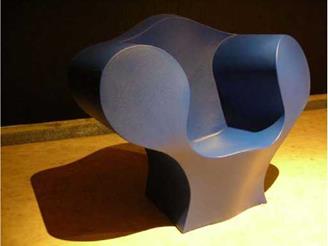Furniture craftsmen emerged in the United States soon after World War II, seeking to create works of beauty using handcraft technologies. They were somewhat resistant to the industrialization and mechanization in which the country was immersed and were often associated with studio furniture, which was crafted using machine and hand tools. George Nakashima, Wendell Castle, and Sam Maloof were renowned for their studio-based practices, producing some of the most refined and well-crafted furniture pieces from the post-World War II period to the 1980s, though the tradition continues today.
New Craftsmanship
New craftsmanship is marked by the hybridization of craft and industry. In this context, architects and designers work closely with industry to produce furniture that either depends upon industrial production processes or industrial materials. The results have a high degree of workmanship and pronounced qualities of form.
Frank O. Gehry (b. 1929) studied design and ceramics at the University of Southern California. After doing graduate work at Harvard’s Graduate School of Arts, Gehry set up his practice in Los Angeles in 1962. His furniture is distinguished by a sense of form marked by a disciplined use of material. The "Easy Edge" series gives aesthetic dimension to the everyday material, cardboard. The Wiggle Side is made from 70 layers of corrugated cardboard, laminated with repeated curved contours, hidden screws, and fiberboard edging. His corrugated cardboard chairs of the early 1970s (Figure 10.71) led to more technically challenging laminated maple veneer chairs in the 1990s (see Chapter 4), and recently, Gehry has produced a line of roto-molded plastic outdoor furnishings. Gehry’s furniture designs weave together material, form, and an economy of fabrication.
Figure 10.71 Wiggle Side chair, from the Easy Edge series of corrugated cardboard furnishings, designed by Frank O. Gehry (1972) for Knoll International. Photography by Jim Postell, 2006.

 Figure 10.72 Soft Big Easy chair, designed by Ron Arad (1988-1991) for Moroso. 48% inches wide; 36% inches deep; 38% inches high (124 cm wide; 92 cm deep; 98 cm high). Photography by Jim Postell, 2006.
Figure 10.72 Soft Big Easy chair, designed by Ron Arad (1988-1991) for Moroso. 48% inches wide; 36% inches deep; 38% inches high (124 cm wide; 92 cm deep; 98 cm high). Photography by Jim Postell, 2006.
Philippe Starck (b. 1949) has had a career as a furniture designer, product designer, interior designer, and architect. His works have a pronounced and often esoteric sense of meaning and sense of humor.
Ron Arad (b. 1951) is an architect, artist, and furniture designer whose work runs the gamut from individually crafted pieces to mass-produced furniture. He was born in Israel and has worked in his London-based studio (One-Off) designing and producing remarkable furniture throughout his professional career. The Soft Big Easy chair (1988-1991) utilizes a steel and wood frame that supports a single block of variable-density expanded polyurethane foam, cut to shape by a computer numeric controlled (CNC) device and then covered with leather or fabric (Figure 10.72). His background and knowledge of materials and his
practice of making full-sized prototypes using industrial materials and the skilled workmanship of a craftsman have resulted in a series of furniture pieces that embody the spirit of new craftsmanship.



